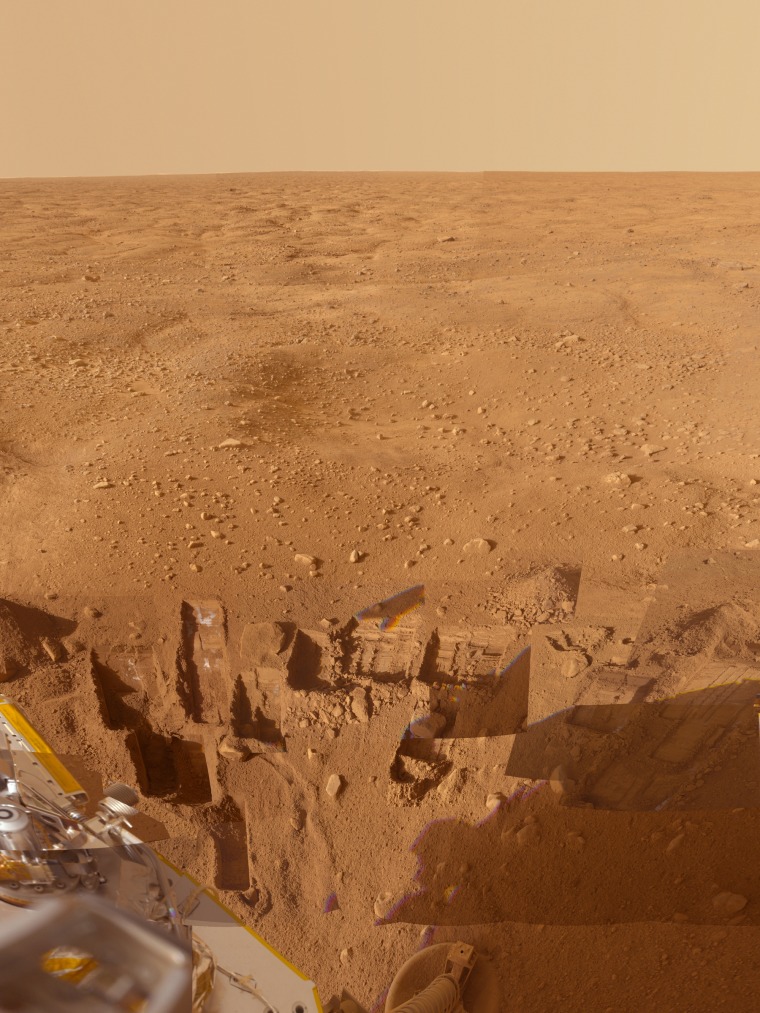Gullies, channels and other features on the Martian surface have long suggested that water flowed across the Red Planet long ago. But a growing number of observations show frozen water is there now.
The findings of NASA's Phoenix Mars Lander, announced throughout the mission, are now detailed in a set of four papers in Friday's issue of the journal Science. They are the first to describe the northernmost reaches of the Red Planet and shed light on the history of water on Mars, as well as the planet's potential habitability.
Among the most significant finding from Phoenix, which landed on the Red Planet on May 25, 2008: a layer of rock-hard water ice just a few inches beneath the surface of the dusty arctic plains.
Phoenix unearthed other surprises: The Martian dirt at Phoenix's landing site proved to be unexpectedly clumpy and contained some compounds that set it apart from the sites that the lander's rover cousins have been investigating.
Water confirmed
Phoenix was sent to the Vastitas Borealis plains of Mars in part to confirm observations from NASA's Mars Odyssey orbiter (still circling the Red Planet) that showed signatures of water ice beneath the surface of the region.
Using its robotic arm, Phoenix dug into the Martian surface to see if it could reach the ice below.
In one trench, dubbed "Dodo-Goldilocks," the lander exposed what mission scientists described as "bright material" about 4 to 5 centimeters (2 inches) below the surface (a similar patch was seen below the lander itself, likely exposed by the spacecraft's landing thrusters). Over the next two months, the team watched as Phoenix's cameras showed that the material was sublimating away, which would be expected of water ice exposed to the Martian atmosphere.
The tendency of soil samples scooped up by the lander to clump together made it difficult to get the samples into Phoenix's onboard instruments, but after several attempts, a sample was coaxed in. The lander's detectors confirmed that there was indeed water ice hiding under the regolith. The confirmation was originally announced last July 31.
Interestingly, the ice seems to occur at different depths under the surface, depending on the terrain. The plains where Phoenix landed feature polygonal mounds surrounded by troughs that result from the seasonal expansion and contraction of the ice underneath the surface, which creates cracks and crevices.
The ice below the center of the mounds was fairly shallow, "but in the troughs in between, we went down as much as 8 inches and never did find the ice underneath," said the mission's principal investigator, Peter Smith of the University of Arizona.
Just how the ice got there is still not known, though researchers have a few theories.
"It could have been the remnant of a larger polar ice cap that shrank; could have been a frozen ocean; could have been a snowfall frozen into the ground," Smith said. "The most likely theory is that water vapor from the atmosphere slowly diffused into the surface and froze at the level where the temperature matches the frost point."
Surprising soil
Just as interesting as the water ice itself are the chemical signs in the soil that liquid water interacted with the soil in the past.
Phoenix's instrument detected a range of compounds and elements in the soil, but two were of particular interest because they imply reaction of the dirt with water.
Slideshow 12 photos
Month in Space: January 2014
Calcium carbonate was detected by Phoenix's Thermal and Evolved-Gas Analyzer, or TEGA, which heated up samples and then analyzed the gases coming off them.
Conditions on early Mars were expected to be ideal for the formation of carbonates, but few have been detected by orbiters or surface missions to the Red Planet. The calcium carbonate, which makes up only about 3 to 5 percent of the soil by weight at Phoenix's site, likely formed in the past when carbon dioxide in the atmosphere interacted with films of water on soil particles.
The carbonate also acts as a buffer that gives the soil an alkaline pH (about 7.7), a marked contrast from the acidic soils seen in other Martian locations. An alkaline soil environment is also interesting because it is similar to that found in many habitable environments — for example, Earth's oceans.
Puzzling over perchlorate
The other chemical standout was a compound called perchlorate, a highly oxidizing substance.
"Perchlorate was not predicted at this landing site and nobody had it on their list of likely chemicals," Smith said. "There was a very high concentration of it, higher than the salts we might have expected like sodium chlorate."
Perchlorate is an interesting find because it has "a strong affinity for water," Smith said, adding: "On Earth, microbes use it as a chemical energy source."
These findings will help inform scientists' understanding of Mars' past and provide evidence of a place where any potential life could have thrived.
"Who knows? Evolution is a powerful force. If life ever started on Mars, there are niches where it could still survive," Smith said.
An earlier version of this report mischaracterized sodium chlorate.

